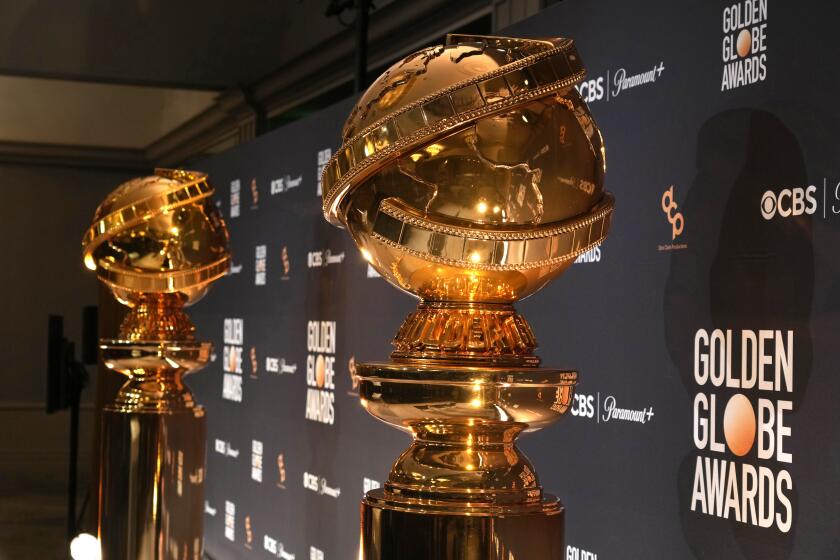No time to waste
- Share via
An installation of paintings, sculptures and drawings by Margaret Kilgallen travels back in time to a place on the outskirts of town where surfers, fiddlers and cooks go about their business as if nothing could stop them. Most have an expression of don’t-mess-with-me determination on their quickly drawn faces: brows furrowed, eyes narrowed, cheeks creased and mouths tightly shut. Most are women. None is rich. And every last one looks as if she couldn’t care less about the maddeningly rapid pace of life in the big city, where modern technology’s time-saving devices bring the future into the present, often before anyone’s ready.
At the Gallery at REDCAT, “Margaret Kilgallen: In the Sweet Bye & Bye” welcomes visitors to a world that is scruffy, endearing and strong, so far removed from the slick glamour of corporate culture that it seems to belong to a bygone era romanticized by old folks, especially when they grow weary of the impersonal world around them. But Kilgallen cuts through tired nostalgia with a sobering dose of realism. Factory smokestacks, panhandlers, soup kitchens, penny pinchers and run-down main drags appear in her crisply painted pictures. All lack the sugary sentimentality of idealized visions.
The world embodied by Kilgallen’s no-nonsense street scenes and portraits is the world of her imagination, which was never far from the real thing. It’s where the Bay Area artist lived until she was 33, when she died of cancer in 2001, leaving behind a newborn daughter and a husband, artist Barry McGee.
The nearly 300 mostly small works in the exhibition were made from 1997 to 2001. Inspired by the outdated typefaces of letterpress printing, old-time carnival billboards, hobo graffiti and homemade signs on markets, bars and garages, Kilgallen’s easy-to-read images have the punch of street graphics: They look great from a distance and get your attention in a split second.
Many depict solitary women, surfing, swimming, smoking or striding down the street. They range from the very old to the very young. None looks naive or gullible. Some simply stand and stare, with defiance, sadness, anger, satisfaction, boredom or sweetness written on their plain faces. As a group, they are tough yet vulnerable.
Other works depict anonymous couples. These suggest relationships tested by the struggle to make ends meet and the hard work of wrestling some pleasure from the daily grind. A few of Kilgallen’s paintings show groups of people -- a mariachi band, shoppers in a pawnshop and folks on a street corner. On the whole, however, her nifty pictures zero in on single moments.
They also hold up in close-up. None is precious, belabored or fussed over. Such niceties of fine art as brushstrokes, translucency and tonal gradations are nowhere to be found. Instead, Kilgallen’s style has more in common with house painting and sign making, artisanal tasks performed by hourly wage-earners.
One series, painted on rusted metal rectangles, resembles homemade signs for such out-of-the-way, salt-of-the-earth places as Roseville, Salinas, San Lucas and San Onofre. Kilgallen made another series from the leftovers of previous works, cobbling together bits and pieces to form abstract collages of colliding patterns and language fragments. Taking recycling one step further, she built two shacks, complete with doors, windows and shingles, out of similar scraps. One is about the size of a doghouse; the other, shaped like a lighthouse, reaches to the ceiling of the large gallery.
A good-enough-to-get-the-job-done quality animates Kilgallen’s paintings, which are direct, confident and unafraid to let the little quirks of her hand show through. This enhances the impression that her works were made with time in mind -- not quite on deadline but with the knowledge of what an hour’s work is worth and, behind that, a profound awareness of mortality.
To look closely at Kilgallen’s paintings is to see that her compositions have not been measured into equal sections but eyeballed or approximated. An intuited looseness and playfulness comes through, intensifying the bittersweet tenor.
Unlike many contemporary artists, whose goal is to make bigger and better works that eventually reach the level of masterpieces, Kilgallen kept her art simple. Each piece has a one-shot quality to it, as if it were made in one session, with a limited palette (red, black and white, or yellow, brown and blue) and with no going back for revisions or refinements.
When Kilgallen installed her own work, she often painted temporary images on the gallery walls, then hung other panels she had painted over and around the mural-scale images. These sprawling clusters created a wonderfully ad hoc, mix-and-match atmosphere. As many as 100 works would be abutted and juxtaposed to form a constellation of pictures that had a poetry all their own.
This exhibition includes 10 such clusters. Some duplicate large parts of previous installations. Others are arranged by McGee and the director and curator, Eungie Joo, in new combinations. No wall paintings have been re-created, but a huge unstretched canvas and many 4-by-8-foot sheets of painted plywood fill the space with rambunctious, funky energy.
It’s as if Kilgallen’s works are social creatures, never apart from their relatives and cohorts but constantly traveling through overlapping circles of friends, mates and acquaintances. Although each piece holds its own, there’s strength in numbers, the whole is greater than the sum of its parts, and strangers are always welcome.
*
‘Margaret Kilgallen: In the Sweet Bye & Bye’
Where: The Gallery at REDCAT, 631 W. 2nd St., Los Angeles
When: Noon to 6 p.m. (or curtain time) Tuesdays through Sundays; closed Mondays
Ends: Aug. 21
Price: Free
Contact: (213) 237-2800, www.redcat.org
More to Read
The biggest entertainment stories
Get our big stories about Hollywood, film, television, music, arts, culture and more right in your inbox as soon as they publish.
You may occasionally receive promotional content from the Los Angeles Times.










